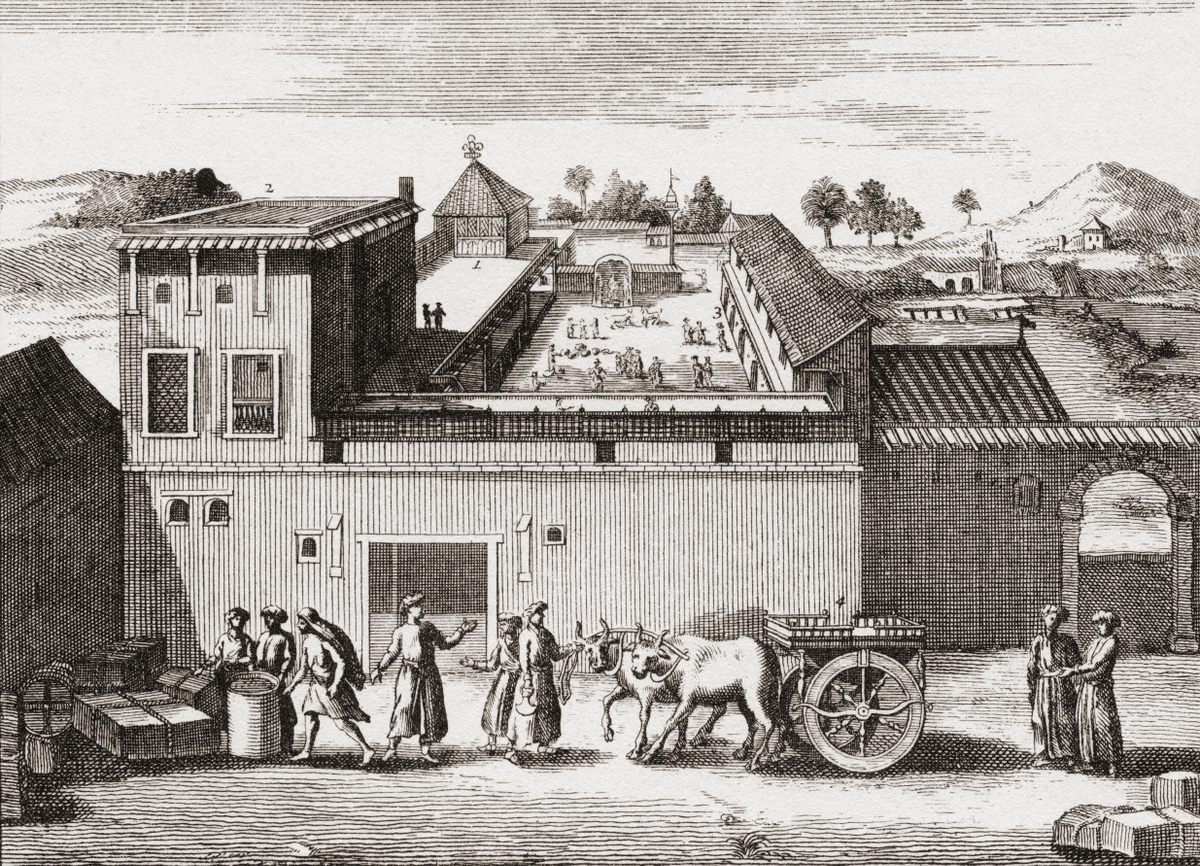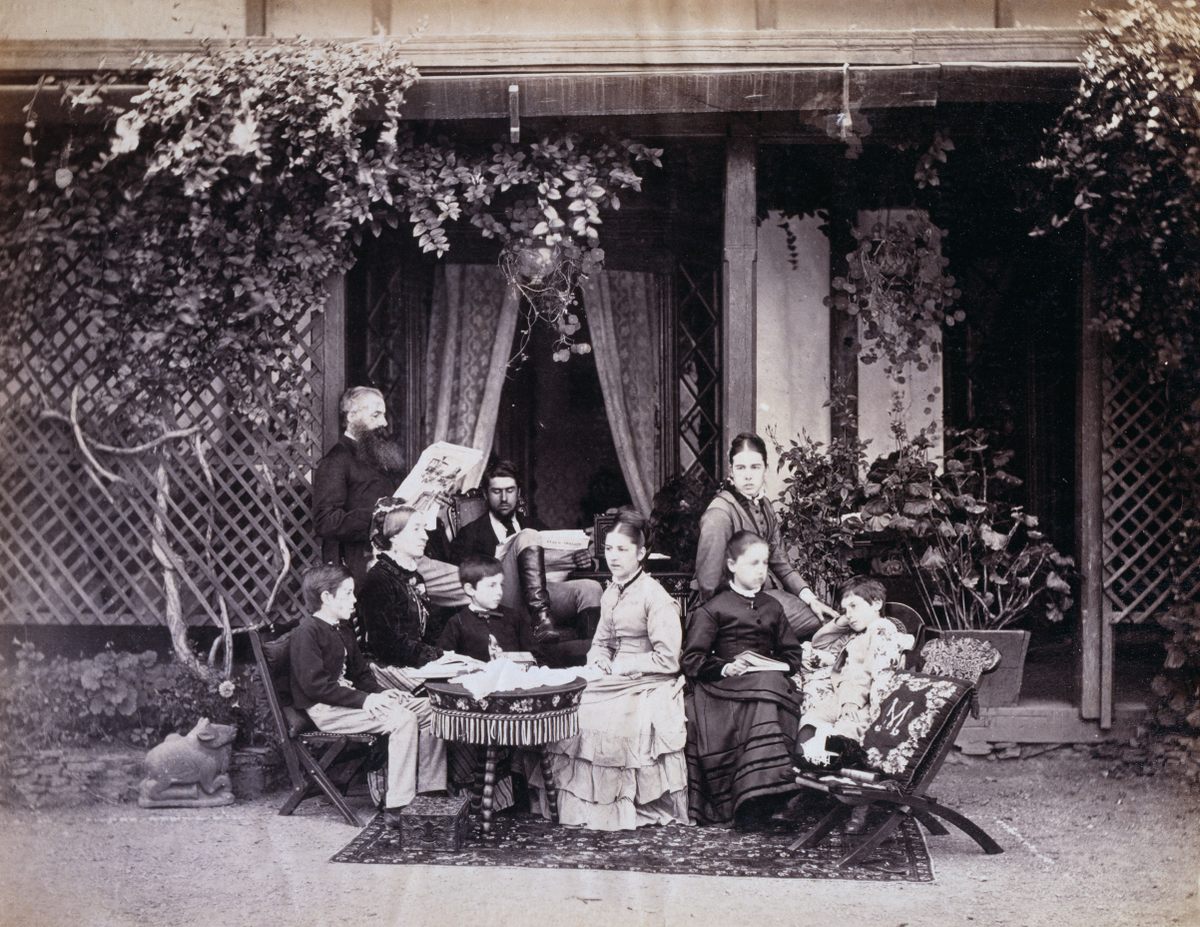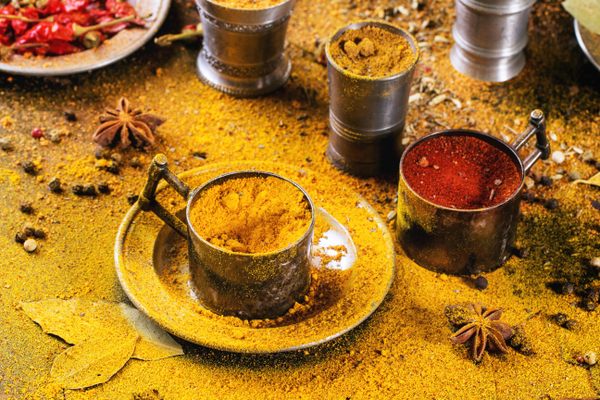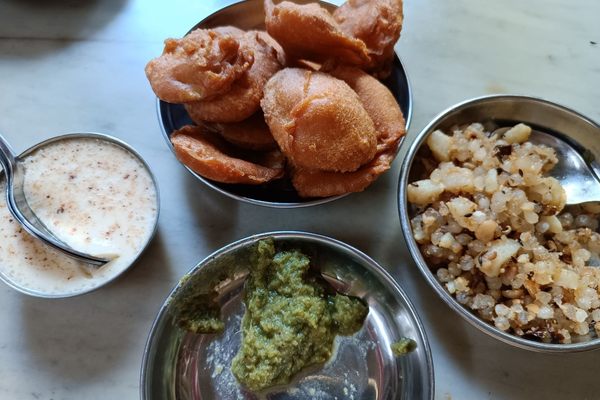

The Curious Case of Colonial India’s Breakfast Curries
Even as the British Empire appropriated curry, authentic versions conquered local officials’ tables.
“By an Indian breakfast by no means must be understood that simple bread, tea, and butter, which compose an English one.” Edward Fane, the nephew of the British General Sir Henry Fane, devotes a lot of time to describing breakfasts in his memoir of their travels through India, then a British colony, in 1858. Describing the morning meals of local English families, he notes that they include meat and fish and eggs, as well as “the eternal curry and rice.”
This is what the British Raj commonly ate for breakfast: breakfast curry.
You might, like many people, think of curry as a bastardization of Indian food, even a hurtful slur. India’s regional cuisines are hugely varied, multiple, nuanced, delicious; rejecting curry is a way of rejecting their oversimplification or appropriation. Curry is colonial, it gestures at India with only the waviest of hands, it’s been co-opted since British people came to India in 1608 and misheard “kari.” These sentiments have been echoed over the past decades, both by academics and even the great actress and cookbook author Madhur Jaffrey, who wrote, “To me the word ‘curry’ is as degrading to India’s great cuisine as the term ‘chop suey’ was to China’s.”
Given the rich history of chop suey, this may be a more apt comparison than Jaffrey intends. Although curry is often described as an invention of British colonizers, Indians ate what non-Indians call curries long before the British arrived, and Indians across India still eat all kinds of curry today. Curry is not a colonial relic.
In colonial India itself, curry wasn’t solely the site of exploitation and domination; curry was a two-way street. Colonial food was not just one homogeneous mulligatawny but a dynamic cuisine based on shifting power relations between the imperial government and their local contacts, relations, and staff. Curries are the dishes that best encapsulate historian Cecilia Leong-Salobir’s argument that Anglo-Indian food was a site of active negotiation between colonial officials and their Indian staff, especially their cook. Colonial food was a give-and-take marked by “mutual accommodation.” British colonizers’ fondness for spicy and savory breakfast curries—so different from the sausages and eggs they grew up on—isn’t just a historical curiosity; it’s a testament to Indian food’s resistance to cultural domination.

Partially, this is because the nature of British colonial presence in India shifted significantly over the centuries, and along with it, colonial food culture. In the late 1700s and early 1800s, British people working in India for the British East India company were mostly single men. They ate mostly Indian food; to be more specific, they were heavily dependent on their Indian servants and so ate regional foods of the Bombay (Mumbai), Madras (Chennai) and Calcutta (Kolkata) Presidencies.
“Until the end of the eighteenth century, there was little sense of racial superiority among the British, whose main motivation was profit,” Colleen Taylor Sen writes in Curry: A Global History. “Company men lived much like the native population: they spoke Indian languages; took Indian mistresses and wives; wore Indian clothes; and consumed Indian meals prepared by local cooks.” These meals centered the foods cooked and eaten by meat-eating Indian Muslim communities at the time, namely creamy, Persianate qormas and qalias: curries.
As British rule formalized and stabilized, British colonial officials living for decades in India started to call themselves Anglo-Indians (the term now refers to their mixed-race descendants). Culinary fusions developed too, such as kedgeree, which contains so much flaked fish it’s pretty much nothing like the dal and rice khichdi that it’s based off of. But when it came to curry, 19th-century cookbook recipes seem surprisingly authentic. All these recipes call for whole spices or ground whole spices; they feature cooking methods still common in India today. Although some colonial cookbook authors did tamp down the heat and spice of curries, this wasn’t uniformly the case. The Economical Cookery Book’s korma calls for eight whole red chiles. A recipe for one masala from the army surgeon at the court of the Nizams of Hyderabad calls for a whopping 12 green chilis.
These cookbooks demonstrate that for British imperial officers, there wasn’t just one generic, bastardized “curry” but a range: vindaloos, Malay curries with lemongrass, so-called Hoosainee curries that typically require first the mincing and grilling of seekh kebabs. Some of these breakfast curries read as distinctly Victorian (beef curry made with the trimmings of last night’s roast), while others seem to be quite accurate representations of local South Indian breakfasts (“Pepper Water, or Rasam”), even if rasam is strictly speaking neither curry nor breakfast. In the separate chapter devoted to breakfast curries in the Economical Cookery Book, there’s fish curry, prawn curry, onion-based do pyaza curries, various moilees of fish, egg, or potato. In a rare surviving cookbook written by a servant, Daniel Santiagoe enumerates still other regional curry variations, such as, “Delhi Curry, Agra Curry, Curry à la Punjab… I myself… will be glad to recommend Madras Curries as best.”
As these trading communities of Europeans in India shifted into direct rule by the British Army and colonial officers—with the establishment of the British Raj in 1858 and Queen Victoria installed as Empress of India in 1877—these food cultures shifted again. Officers’ wives and children joined them to establish permanent residencies in India, and Anglo-Indian cookery became much more Anglo, especially as British wives took over “oversight” of the kitchen staff. British officers entertained each other over roasts and potatoes for dinner: “strictly English, no peculiarities” according to memoirist Colesworthy Grant. But breakfasts stayed Indian. Anglo-Indians still ate curry—just not when other British people were around.
Keeping up colonial appearances demanded offering guests tinned asparagus, imported butter, and dinner tables overflowing with British foods, and so breakfast curry became, for Anglo-Indians, a kind of guilty pleasure. According to historian Mary Procida, one snobby British Army wife was discovered by another army wife, “squatt[ing] on the sofa demolishing a plate of curry-and-rice! The curry was obviously fiery with chillies … Then realising that she had been properly caught enjoying the very stuff for which she and her set evinced such contempt; stuff that ‘the servants eat and which never appeared on her table’ – the wretched woman uttered a shriek of dismay and fled from the room!”

Which brings us back to breakfast curry. The 1894 Mem Sahib’s Book of Cookery states, “curry is eaten in almost every household at least once daily, generally at breakfast.” Colonial official and household manual author Albert Kenney-Hebert elaborates: “The molten curries and florid oriental compositions of the olden time—so fearfully and wonderfully made—have been gradually banished from our dinner tables; although a well-considered curry or mulligatawny… are still very frequently given at breakfast.”
It’s unclear whether a phrase like “fearfully and wonderfully made” is meant as a genuine compliment or sarcastic barb. And indeed some of these 19th-century colonial accounts of curry were demeaning—writers call them “greasy” or “sweet” or “so entirely of an Asiatic character and taste that no European will ever be persuaded to partake of them.” One of the most famous authors of these cookbooks wrote anonymously under the moniker “the thirty-five years resident,” stressing his Indian bona fides. But apparently even 35 years in India didn’t warm him up to Indian foods: He describes qorma curries as “quite unsuited to European taste” and offers an alternative recipe without the dish’s characteristic aromatic spices such as clove and black cardamom.
But these dismissive writers were the exception. You get the sense from reading colonial cookbooks that, for the most part, the men and women who authored these texts did so because they liked curry: they wanted to learn more about it, and document how to make it. An anonymous colonial official’s wife reports: “In the end, we simply loved their curry and rice. It was delicious.”
Strikingly, the writers of these cooking manuals clearly knew the difference between a Madras-style fish curry (tamarind, fenugreek seeds, mustard seeds, tomato, curry leaves) and a New Zealand Curry (“much appreciated”) of beef, potatoes, carrots, and two heaping tablespoons of Madras Curry Powder. These writers knew, the juxtaposition of these two recipes suggests, the difference between authentic and inauthentic versions of Indian food and they liked them both for different reasons. Even though the 35-Year Resident insults the original qorma in The Indian Cookery Book, he nonetheless offers his readers a printed version of a more typical qorma recipe alongside his own blander “gentleman’s” one.

If anything, breakfast curry shows that by the late 1800s Anglo-Indians prided themselves on their abilities to perform both sides of that hyphen. Paradoxically, as the British colonial government became increasingly institutionalized, underscored by increasingly bigoted programs of racial difference, curries became a more intimate part of Anglo-Indians’ diet. Breakfast curry was a break from conspicuous consumption, from demonstrating knowledge of the latest European dining trends, from the seemingly ceaseless work of entertaining that formed the cultural backbone of British colonial life. Many British officials, it seems, were nostalgic for the days of social integration. They were nostalgic for curry.
Of course, these cookbook authors and household manual writers and memoirists weren’t doing the actual cooking. These recipes belong to the household manager, the khansama, or the cook (bawarchi) who prepared breakfast curries alone, before the British woman head of household officially took over the kitchen and household management duties. The written record of colonial food tells the story from the British side, but we can read between the lines a different story: of Indian cooks whose skills, and whose culinary traditions, overcome Anglo-Indians’ pretensions to conquer their dining tables throughout, eventually, the whole British Empire.

Most of today’s conversation about curry and colonialism focuses on curry powder—how English businessmen cheapened India’s diverse masalas by marketing instead a single spice blend of mainly turmeric, how curry powder’s imperial spread to Britain and its colonies served to incorporate the “exotic” subcontinent into the English body politic.
The spread of curry and curry powder is often presented as something done to hapless Indians by their colonizers. But curry also represents the durability and flexibility of Indian culinary traditions, the talent and influence of the cooks who made and make them. British people tried to emulate the taste of Indian regional foods for centuries, even if all they could muster was a pale imitation. Looking closer at the eating patterns of the British Raj, the clandestine breakfast curries of 19th-century India, allows us to better understand the history of colonialism without celebrating it. Breakfast curry shows us curry’s unceasing appeal, even in a colonial empire loath to admit the superiority of anything created outside England.
Gastro Obscura covers the world’s most wondrous food and drink.
Sign up for our email, delivered twice a week.






























Follow us on Twitter to get the latest on the world's hidden wonders.
Like us on Facebook to get the latest on the world's hidden wonders.
Follow us on Twitter Like us on Facebook